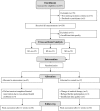Exercise and Arterial Stiffness in the Elderly: A Combined Cross-Sectional and Randomized Controlled Trial (EXAMIN AGE)
- PMID: 31551805
- PMCID: PMC6738015
- DOI: 10.3389/fphys.2019.01119
Exercise and Arterial Stiffness in the Elderly: A Combined Cross-Sectional and Randomized Controlled Trial (EXAMIN AGE)
Abstract
Introduction: Arterial stiffness (AST) is a main determinant of cardiovascular (CV) mortality. Long-term physical activity (PA) is considered to decrease age-related progression of AST but effects of short-term exercise interventions on AST remain unclear.
Methods: In a combined cross-sectional and interventional study approach, we investigated the effects of long-term PA and short-term high-intensity interval training (HIIT) on AST in an older population. 147 older individuals (mean age 59 ± 7 years) were assigned to three groups according to their PA and CV risk profile and compared: healthy active (HA, n = 35), healthy sedentary (HS, n = 33) and sedentary at risk (SR, n = 79). In addition, SR were randomized to either 12 weeks of HIIT or standard recommendations. Pulse wave velocity (PWV) was measured by applanation tonometry. Cardiorespiratory fitness (CRF) was performed by symptom-limited spiroergometry to determine maximal oxygen uptake (VO2max).
Results: Higher CRF was associated with lower PWV (p < 0.001) and VO2max explained 18% of PWV variance. PWV was higher in SR (8.2 ± 1.4 m/s) compared to HS (7.5 ± 1.6 m/s) and HA (7.0 ± 1.1 m/s; p < 0.001). 12 weeks of HIIT did not change PWV in SR. HIIT-induced reduction in systolic BP was associated with a reduction in PWV (p < 0.05).
Discussion: SR show higher PWV compared to HS and long-term PA is associated with lower PWV. Reduction of AST following short-term HIIT seems to depend on a concomitant decrease in blood pressure. Our study puts into perspective the effects of long- and short-term exercise on arterial wall integrity as treatment options for CV prevention in an older population.
Clinical trial registration: ClinicalTrials.gov: NCT02796976 (https://clinicaltrials.gov/ct2/show/NCT02796976).
Keywords: aging; cardiovascular risk; high-intensity interval training; physical activity; pulse wave velocity.
Figures





Similar articles
-
Exercise, Arterial Crosstalk-Modulation, and Inflammation in an Aging Population: The ExAMIN AGE Study.Front Physiol. 2018 Feb 21;9:116. doi: 10.3389/fphys.2018.00116. eCollection 2018. Front Physiol. 2018. PMID: 29515458 Free PMC article.
-
Physical activity and markers of glycation in older individuals: data from a combined cross-sectional and randomized controlled trial (EXAMIN AGE).Clin Sci (Lond). 2020 May 15;134(9):1095-1105. doi: 10.1042/CS20200255. Clin Sci (Lond). 2020. PMID: 32356559 Clinical Trial.
-
Effects of Different Exercise Modes on Arterial Stiffness and Nitric Oxide Synthesis.Med Sci Sports Exerc. 2018 Jun;50(6):1177-1185. doi: 10.1249/MSS.0000000000001567. Med Sci Sports Exerc. 2018. PMID: 29381650 Clinical Trial.
-
The effect of high Intensity interval training versus moderate intensity continuous training on arterial stiffness and 24h blood pressure responses: A systematic review and meta-analysis.J Sci Med Sport. 2019 Apr;22(4):385-391. doi: 10.1016/j.jsams.2018.09.228. Epub 2018 Sep 22. J Sci Med Sport. 2019. PMID: 30803498
-
Effect of antihypertensive agents on arterial stiffness as evaluated by pulse wave velocity: clinical implications.Am J Cardiovasc Drugs. 2001;1(5):387-97. doi: 10.2165/00129784-200101050-00008. Am J Cardiovasc Drugs. 2001. PMID: 14728020 Review.
Cited by
-
Comparing the Effects of Two Cardiovascular Health Factors on Working Memory Capacity in Healthy Aging: Separate and Combined Effects of Arterial Elasticity and Physical Fitness.J Gerontol B Psychol Sci Soc Sci. 2022 Jan 12;77(1):94-103. doi: 10.1093/geronb/gbab071. J Gerontol B Psychol Sci Soc Sci. 2022. PMID: 33914083 Free PMC article.
-
Associations of habitual physical activity and carotid-femoral pulse wave velocity; a systematic review and meta-analysis of observational studies.PLoS One. 2023 Apr 6;18(4):e0284164. doi: 10.1371/journal.pone.0284164. eCollection 2023. PLoS One. 2023. PMID: 37023122 Free PMC article.
-
Associations between physical activity and cardiorespiratory fitness with vascular health phenotypes in older adults: a cross-sectional study.Front Physiol. 2023 May 15;14:1096139. doi: 10.3389/fphys.2023.1096139. eCollection 2023. Front Physiol. 2023. PMID: 37256064 Free PMC article.
-
Blood Pressure Increase and Microvascular Dysfunction Accelerate Arterial Stiffening in Children: Modulation by Physical Activity.Front Physiol. 2020 Dec 17;11:613003. doi: 10.3389/fphys.2020.613003. eCollection 2020. Front Physiol. 2020. PMID: 33391029 Free PMC article.
-
Predictors of arterial stiffness in adolescents and adults with type 1 diabetes: a cross-sectional study.BMJ Open Diabetes Res Care. 2022 Jan;10(1):e002491. doi: 10.1136/bmjdrc-2021-002491. BMJ Open Diabetes Res Care. 2022. PMID: 34987053 Free PMC article.
References
-
- Ben-Shlomo Y., Spears M., Boustred C., May M., Anderson S. G., Benjamin E. J., et al. (2014). Aortic pulse wave velocity improves cardiovascular event prediction: an individual participant meta-analysis of prospective observational data from 17,635 subjects. J. Am. Coll. Cardiol. 63 636–646. 10.1016/j.jacc.2013.09.063 - DOI - PMC - PubMed
-
- Ciolac E. G., Bocchi E. A., Bortolotto L. A., Carvalho V. O., Greve J. M., Guimaraes G. V. (2010). Effects of high-intensity aerobic interval training vs. moderate exercise on hemodynamic, metabolic and neuro-humoral abnormalities of young normotensive women at high familial risk for hypertension. Hypertens. Res. 33 836–843. 10.1038/hr.2010.72 - DOI - PubMed
Associated data
LinkOut - more resources
Full Text Sources
Medical
Research Materials

